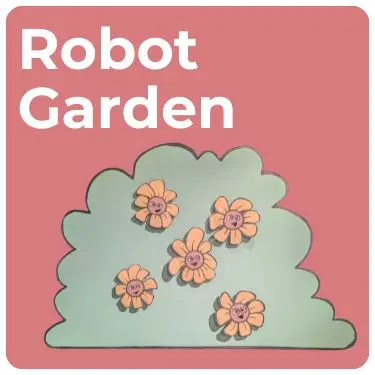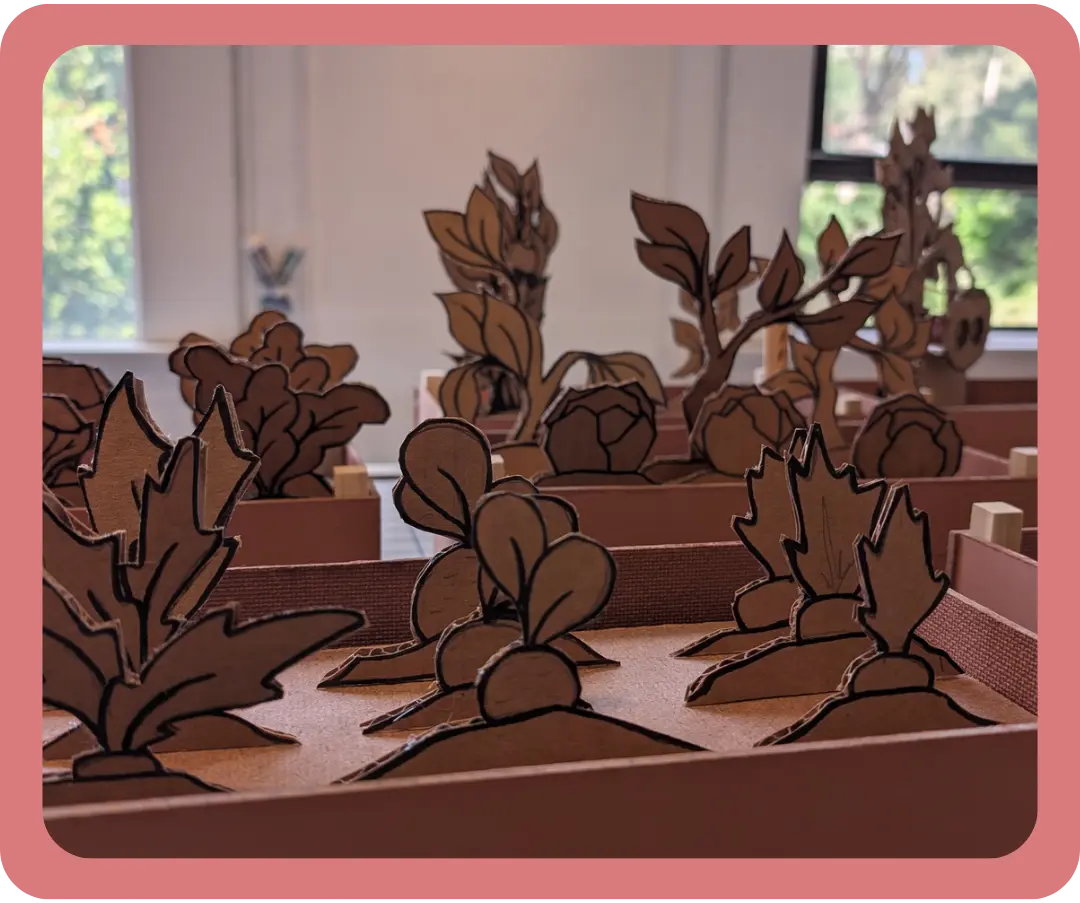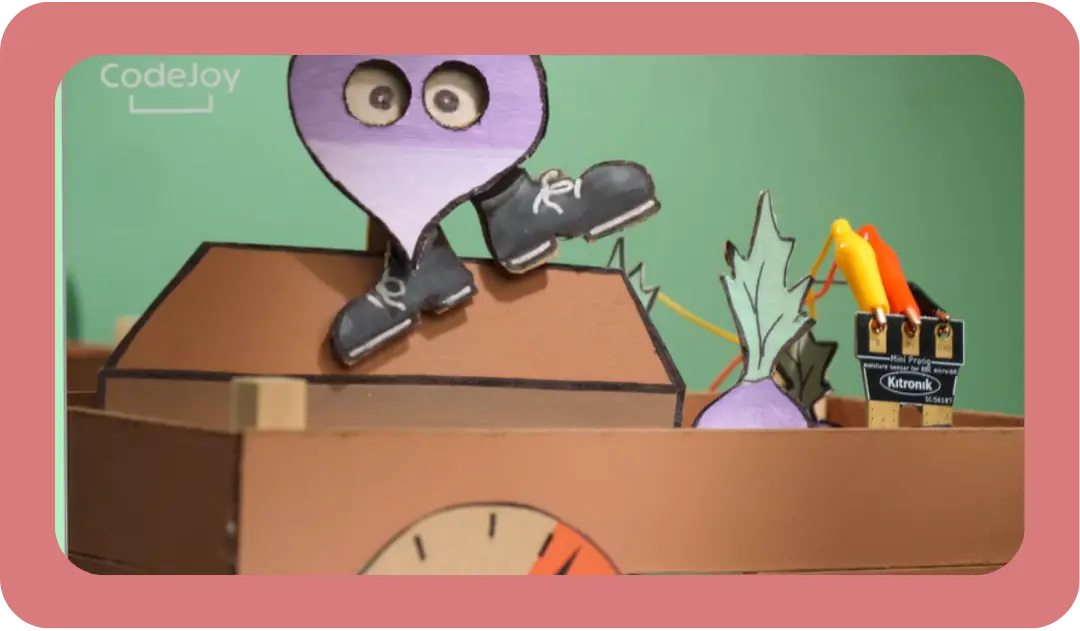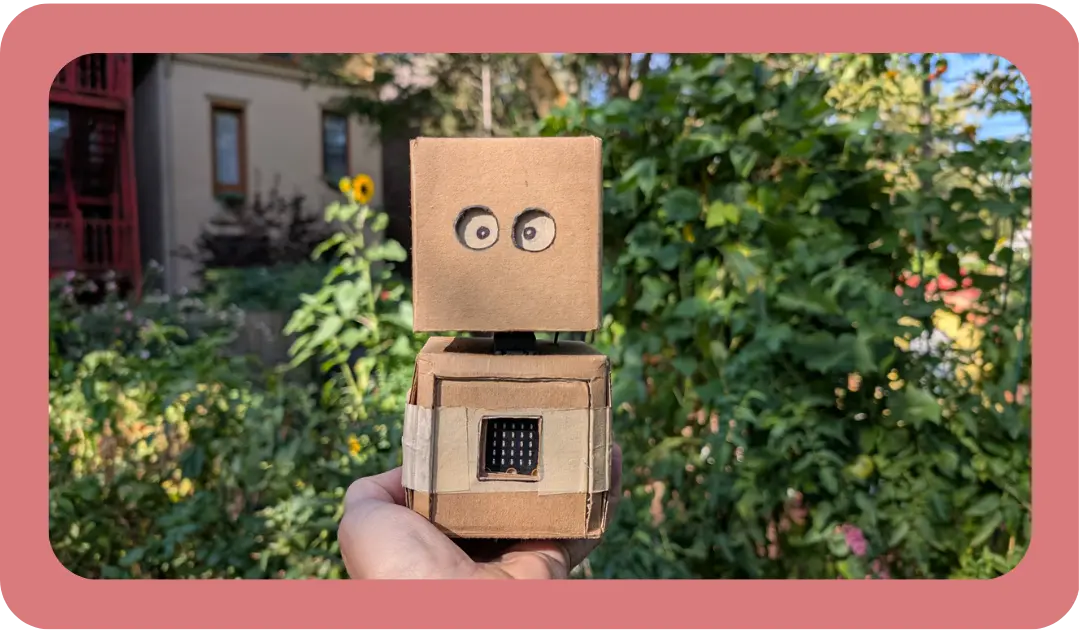Welcome to the whimsical world of Robot Garden, where Elby helps his grandma tend to her garden with a touch of robotic charm! Get ready for a behind-the-scenes look at how we brought this delightful show to life, from singing flowers inspired by Alice in Wonderland to clever engineering solutions for watering cardboard plants. Join us as we explore the creative journey, the silly challenges, and the heartwarming moments that made Robot Garden bloom!
Amanda Jeane Strode (AJ): What is Robot Garden?
Kelsey Derringer (KD): Robot Garden is our newest show and it's all about Elby helping his grandmother take care of her garden. One of the fun things about this show is that all of the tasks that Grandma has left for Elby to complete are ridiculous. Things like play a pinochle with the parsnips and ring the bell peppers and teach the turnips how to tap dance. All very silly things. But there's some real precision agriculture in it as well, because we also talk about what soil moisture sensors are, how they work, and how they can be used in a garden. One exciting thing about this show is that it has a tie-in to the FarmBeats for Students curriculum which we've recently begun teaching.
AJ: Where did the idea for robot garden come from?
Matt Chilbert (MC): We knew we wanted to do a garden show because we've been working in and around environmental literacy for quite some time. A garden show seemed like a natural pathway for Codejoy into outdoor learning. Why we were excited about making it, however, was because we're both big fans of Disney's Alice and Wonderland, and there's some great garden scenes in that that we wanted to take inspiration from and do a fun CodeJoy spin on.

KD: We watched Alice in Wonderland while we were making the show. We always have movies in the background while we're working. And so the singing flowers really inspired us. Also the hedge maze for the Queen of Hearts were big inspirations visually for the show.
AJ: Let’s talk about the making of the show! We know that our final iteration, many of our student shows, was not the original idea. where did the show start and where did it end up?
KD: I think the first thing we had ready for this show was the title. We wanted to call it Robot Garden and the rest… hilarity ensued. The first creative element that we had ready for this show was actually the opening song from our music director, Bryce Rabbido. He sent this song to us all the way back in December of 2024. We gave him the inspiration of the flower song in Alice in Wonderland; “you can learn a lot of things from the flowers,” Golden Afternoon. Yes. And we said, "How about a Codejoy version of that?" And boy, did he deliver! So we got to sit on that song and listen to it over and over again for about six or seven months before we really got into making the show. Bryce’s track had really become part of our souls by the time we sat down to actually design the show.
KD: What were some of the first elements that you physically made, Matt?
MC: The hedges were actually the first thing that we made. Oftentimes we'll start with sort of a set, right? What is the strong visual of the set? And then we could kind of start imagining kind of how the show unfolds from there. Or at least that's how I like to think about it. The hedges were one of the first things that we made and then we made all of the different garden beds. We knew it was going to be really difficult with our aesthetic to make a garden that was aesthetically pleasing. So containing everything to those garden beds sort of made sense.

KD: It helped keep everything ordered and efficient in a way that that real gardens are not, but CodeJoy sets are often ordered and simple. So those raised garden beds impose some order on a non-orderly thing.

AJ: How did sensors come into the show and what were some of the trials that you faced in getting them in there?
KD: So, one of the main sensors you might use in a real garden might be a soil moisture sensor. This is also a sensor that features prominently in the FarmBeats for Students curriculum. And so, we decided we wanted to tie this into soil moisture sensors, but it wasn't always that way. Initially, we were going to use all kinds of different sensors, soil moisture, sound, light, and we had a different robot for every sensor. But there's a challenge when you're doing remote robotics, which is that the sensors don't matter that much, I guess, because the kids aren't actually interacting with the sensors. They're interacting and controlling the outputs, the motors, the lights. We sat down with Mike (our CTO) to make a working version of CodeJoy Live that worked with a light sensor or sound sensor.
MC: I mean, they all worked. They were just kind of finicky and once we played with them, unsatisfying.

KD: We ended up switching all the robots over to a soil moisture sensor because with a soil moisture sensor, you basically water it and it crosses the threshold once and then it stays there. Which was much more beneficial for the interactions that we wanted the students to have with the robots. But then we had the issue of great, we've got a soil moisture sensor, but we can't get our cardboard robots wet. So there was a lot of rewriting of the show once we focused on that sensor. There was some really creative engineering that we needed to come up with to “water a cardboard robot.” Which also led us to putting a real plant and a real soil moisture sensor in the show, as well, so that we can show this is what it really looks like. And then we created a fake version of that where the water was confetti that we made by hole punching some construction paper.
AJ: I also would love for you guys to talk more about Margot and the singing flowers.
KD: On the way to those singing flowers. It was quite a journey because initially we thought, "Hey, we want singing flowers." And Matt drew a little singing flower and it was really cute. And then as the garden started to come together, initially there was going to be a back wall to the set and we could not figure out where those singing flowers were going to be. So at a certain point in the production of this, they were actually going to be singing apples in an apple tree that hung over the back wall, but It never looked like CodeJoy. The frame was getting too busy. We didn't know how to make them not distract us if they were always going to be in the background. They were bananas at one point. They were lemons at one point. Then we were going to shoot them in super duper closeup and they were going to be teeny tiny flowers. But then there was also this element with the battery fly and this bush that needs to fall over so Elby can go outside. And so ultimately we decided to mount the flowers on that bush that falls over. And that ended up being the right call because they're not distracting in the background. They are singing flowers which is great. They serve a sort of story role in the end of the show. So ultimately I'm really pleased with where we ended up with the role of those flowers in the show.

MC: Those flowers are very popular when they start singing. I could see the chat just light up. The puppets themselves, the little robots themselves are actually quite simple. There's just a little servo that's moving a little mouthpiece. There's not much to them. I think what's actually making them come alive is the vocal performance from Margot Jerzec. Once we heard that first track and we heard what she was bringing to it, we really felt that those flowers should be a really central part of the show. So, they show up over and over again. We make sure to give them a little featured moment basically every time we go to a little pre-recorded bit. But yeah, she is absolutely incredible. You could hear that in the opening song, but if you pay attention really closely in some of the other songs, she's doing weird little scats and making funny little noises in the background, doing a whole bunch of really crazy character work to make these flowers kind of come to life.
AJ: Tell us about the first time you heard the flower track.
KD: So, it's New Year's Eve 2024. Bryce sent us this track a couple days beforehand, and I hadn't gotten a chance to listen to it yet. Bryce was throwing a New Year's Eve party for all of his musician friends and us weird robot puppet people. We all came together and Bryce says hello and he says, " have you listened to the track yet?" And I said, no, I haven't listened to it yet." And so he says, " you'll have to have a chance to." And I said, "How about right now?"
Somebody had a Bluetooth speaker and I said, "can we listen to it right now?" And Bryce was like, "Yeah, of course." So, we crank up the Bluetooth speaker. We start playing the song. And when Margot hears it from across the apartment, she comes running in. And then we all start dancing to this silly song on New Year's Eve. And it was just so fun and so silly. We had hugs and everything. But it was the most ridiculous way anyone has ever listened to a singing flower track.

MC: And something about Bryce and Margot, they are extremely talented and extremely accomplished musicians. There is a part of me that's like, “this must be a fun side thing for them.” But I can't imagine there's much of a fun side project that Codejoy offers. When I heard them enjoying their own track as much as I enjoy their track it was really special. It was really great to see how much pride they took in their work because it's amazing.
KD: For really great artists, there's no such thing as a side project. Really great artists pour themselves into every single thing they do.
AJ: How can teachers bring these ideas into their classroom?
KD: We have a vision for two follow-up projects to go along with Robot Garden. One is a bit more literal, especially for those who are wanting to connect to agriculture, which is an automated plant watering device. You can download our Plant Water Project HERE.

When the soil moisture sensor reads below a certain amount, the motor tips some water into a plant. And so with some craft supplies and some simple materials and some simple code, you can make your very own self-watering plant, which would be very helpful for my mom who has never kept a plant alive for more than two weeks. Our second follow-up project, if what inspired you about Robot Garden was the singing flowers, and we're seeing a lot of positive feedback about those.
We're going to have a moving ma mouth mechanism, a simple moving mouth mechanism, and show you how to build that. So, if you've got a servo, you can make it look like a little character is talking. That should be really fun.
AJ: Is there anything else you'd like to share about Robot Garden?
KD: Making these shows takes a lot of work. It takes a lot of creativity, a lot of engineering. Did we spend an entire Saturday engineering how to water cardboard plants with confetti? Yes, we did. But just because something is hard doesn't detract from the fun of it. This was so much fun to make. We haven't gotten to make a new show for ourselves for three years now. And so both Matt and I, I think, really missed the creative process of creating these shows. It was really fun to come back to that work knowing what we know now, knowing how we use these shows now, knowing who we perform for and who we teach now. So this creative process was difficult and fun and rewarding and just such a joy to come back and engage in again.
Want to bring Robot Garden to your classroom? Check out our Robot Garden page to find our Featured Project: Plant Water Project PDF and Contact Us to start the discussion!